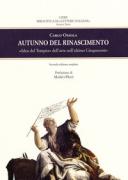Autunno del Rinascimento

Idea del Tempio» dell'arte nell'ultimo Cinquecento
What characterizes the end of the sixteenth century is a series of attempts, attitudes, trials of new agreements that precede what will later interpret the baroque orchestra in full force. This period is that of Mannerism, located between the Apollonian period of the Renaissance and that, Dionysiac, of Baroque. Carlo Ossola painstakingly studied it in this work, relying on texts by poets and critics, especially on art treatises from the second half of XVI Century (Dolce, Gilio, Paleotti, Comanini, Danti, as well as on Varchi, Vasari and Lomazzo). At that time, as Ossola notes, "the limits of things fade away: the word becomes color, the color music and everything can become another". Analyzing the rules of these writings, Ossola highlights the norms with which they tried to fix, save, distinguish a syntax of their own. The effort to walk along the infinite multiplicity of beings and forms is required by the desire to achieve the final reductio ad unum. It is because of this intention, latent or manifest, that we can still distinguish between the "autumn of the Renaissance" and the plurality of perspectives from which is born the meaning of the living and the provisional of the baroque civilization. Published in 1971, updated and expanded in 2014, this reference essay is a great fresco about the end of the Renaissance civilization in Italy.